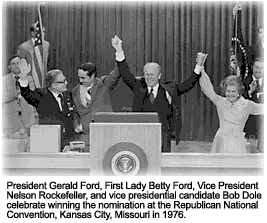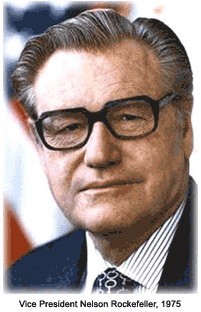 Nelson Aldrich Rockefeller was the third son of John D. Rockefeller Jr. and the grandson of the founder of Standard Oil. He was active in philanthropy and art collecting, but he is best remembered as the first of the Rockefellers to successfully enter elective politics.
Rockefeller, born in Bar Harbor, Maine, on July 8, 1908, was named after his maternal grandfather, Rhode Island Senator Nelson W. Aldrich. From an early age, Nelson was the leader of his four brothers and one sister: Abby Rockefeller Mauzé, John Davison Rockefeller III, Laurance Spelman Rockefeller, Winthrop Rockefeller, and David Rockefeller. He attended school in New York City and graduated from Dartmouth College in Hanover, New Hampshire, in 1930. His parents, Rockefeller Jr. and Abby Greene Aldrich, were active in art collecting, and Nelson quickly gained a role in promoting the work of new American artists in the Museum of Modern Art in mid-town Manhattan, New York. It led to an immediate controversy when one of the murals depicted big American capitalists, including a Rockefeller, as gangsters like Al Capone. Nelson kept the art but displayed it as inconspicuously as possible.
During the World War II years, Rockefeller took positions with the State Department and focused on Latin American affairs. Afterward, he chaired the International Development Advisory Board, which was part of Truman's Point Four Program. The purpose of the Point Four Program was to give technical assistance in education, public health, industry, and especially agriculture, to developing nations to lessen their chances of being overtaken by communism. He also returned to the management of Rockefeller philanthropic interests. With the election of Dwight D. Eisenhower as President, Rockefeller returned to Washington, D.C., and served as chair of the President's Advisory Committee on Government Organization, and later as a Department of Health, Education and Welfare undersecretary.
In 1958, he won the New York governorship as a Republican, a position he held from 1959 to 1973. Governor Rockefeller engaged in such large building projects as converting the State University of New York into the largest public higher education system in the United States and such major highways as the Long Island, the Southern Tier, the Adirondack, and Interstate Eight, which advanced New York State’s road transportation. He also established the toughest anti-drug laws in the country regarding the possession and sale of cocaine and heroine, some of which remain on the books.
As a part of his liberal plans, he created more low-income housing, with unprecedented power given to the New York State Urban Development Corporation, which could override local zoning, condemn property, and develop creative financing schemes to carry out desired development.
To pay for those building projects, Rockefeller established approximately 230 public-benefit authorities like the U.D.C., which issued bonds with a higher interest rate than what the state would have charged. He also raised the minimum wage for workers higher than in any other state at the time. He managed to increase the state budget from $2.04 billion in 1959-60 to $8.8 billion in 1973-74 when he left office, during a time of overall state economic decline.
Nelson Aldrich Rockefeller was the third son of John D. Rockefeller Jr. and the grandson of the founder of Standard Oil. He was active in philanthropy and art collecting, but he is best remembered as the first of the Rockefellers to successfully enter elective politics.
Rockefeller, born in Bar Harbor, Maine, on July 8, 1908, was named after his maternal grandfather, Rhode Island Senator Nelson W. Aldrich. From an early age, Nelson was the leader of his four brothers and one sister: Abby Rockefeller Mauzé, John Davison Rockefeller III, Laurance Spelman Rockefeller, Winthrop Rockefeller, and David Rockefeller. He attended school in New York City and graduated from Dartmouth College in Hanover, New Hampshire, in 1930. His parents, Rockefeller Jr. and Abby Greene Aldrich, were active in art collecting, and Nelson quickly gained a role in promoting the work of new American artists in the Museum of Modern Art in mid-town Manhattan, New York. It led to an immediate controversy when one of the murals depicted big American capitalists, including a Rockefeller, as gangsters like Al Capone. Nelson kept the art but displayed it as inconspicuously as possible.
During the World War II years, Rockefeller took positions with the State Department and focused on Latin American affairs. Afterward, he chaired the International Development Advisory Board, which was part of Truman's Point Four Program. The purpose of the Point Four Program was to give technical assistance in education, public health, industry, and especially agriculture, to developing nations to lessen their chances of being overtaken by communism. He also returned to the management of Rockefeller philanthropic interests. With the election of Dwight D. Eisenhower as President, Rockefeller returned to Washington, D.C., and served as chair of the President's Advisory Committee on Government Organization, and later as a Department of Health, Education and Welfare undersecretary.
In 1958, he won the New York governorship as a Republican, a position he held from 1959 to 1973. Governor Rockefeller engaged in such large building projects as converting the State University of New York into the largest public higher education system in the United States and such major highways as the Long Island, the Southern Tier, the Adirondack, and Interstate Eight, which advanced New York State’s road transportation. He also established the toughest anti-drug laws in the country regarding the possession and sale of cocaine and heroine, some of which remain on the books.
As a part of his liberal plans, he created more low-income housing, with unprecedented power given to the New York State Urban Development Corporation, which could override local zoning, condemn property, and develop creative financing schemes to carry out desired development.
To pay for those building projects, Rockefeller established approximately 230 public-benefit authorities like the U.D.C., which issued bonds with a higher interest rate than what the state would have charged. He also raised the minimum wage for workers higher than in any other state at the time. He managed to increase the state budget from $2.04 billion in 1959-60 to $8.8 billion in 1973-74 when he left office, during a time of overall state economic decline.
 In 1961, Rockefeller's most promising son and cum laude Harvard graduate, Michael, was lost while attempting to reach remote villages in his native catamaran in the interior of Papua, New Guinea, at age 23. When Michael encountered rough water, he decided to swim ashore for help. Nelson organized an extensive search but his son was never found.
Rockefeller unsuccessfully campaigned for the presidency in 1960, 1964, and 1968 but when Richard M. Nixon resigned the presidency in 1974, he came the closest he would in his public career of reaching the highest political office. Vice President Gerald Ford became President, under the provisions of the Twenty-fifth Amendment to the Constitution, and was required to designate a replacement for the office of Vice President. He chose Nelson Rockefeller, who was sworn in on December 19, 1974, and served until the end of Ford’s term in January, 1977.
He died on January 26, 1979 of a heart attack and was cremated soon after. His ashes were buried at the family estate in Pocantico Hills, New York. He was said to have been worth $1 billion at the time of his death. Rockefeller was considered one of the leaders of the moderate wing of the Republican Party, and is hailed as an example of one of the outstanding figures of the "1960s and 1970s Republican" movement. Republicans who hold similar views to his are often called "Rockefeller Republicans."
In 1961, Rockefeller's most promising son and cum laude Harvard graduate, Michael, was lost while attempting to reach remote villages in his native catamaran in the interior of Papua, New Guinea, at age 23. When Michael encountered rough water, he decided to swim ashore for help. Nelson organized an extensive search but his son was never found.
Rockefeller unsuccessfully campaigned for the presidency in 1960, 1964, and 1968 but when Richard M. Nixon resigned the presidency in 1974, he came the closest he would in his public career of reaching the highest political office. Vice President Gerald Ford became President, under the provisions of the Twenty-fifth Amendment to the Constitution, and was required to designate a replacement for the office of Vice President. He chose Nelson Rockefeller, who was sworn in on December 19, 1974, and served until the end of Ford’s term in January, 1977.
He died on January 26, 1979 of a heart attack and was cremated soon after. His ashes were buried at the family estate in Pocantico Hills, New York. He was said to have been worth $1 billion at the time of his death. Rockefeller was considered one of the leaders of the moderate wing of the Republican Party, and is hailed as an example of one of the outstanding figures of the "1960s and 1970s Republican" movement. Republicans who hold similar views to his are often called "Rockefeller Republicans."